IN00189 Mandhal Charter of Prthivisena II, Year 2
The charter consists of four plates, which were found in an earthen vessel during excavations, along with two other Vākāṭaka period copper plate inscriptions. The charter was issued in the second year of Pṛithivīṣeṇa II’s reign and was found complete with ring and seal, providing the earliest known complete example of a copper plate charter from the reign of Pṛithivīṣeṇa II. The charter records the donation of the village Kurubhajjaka by its chief to three brothers, Maheśvarasvāmin, Agnisvāmin and Brahmasvāmin, sons of Māṭrisvāmin. Two of these brothers are also the benefactors of the Māṇḍhaḷ copper plate of Pṛithivīṣeṇa II, year 10 (IN00190) and Māṭrisvāmin was the donee of the Māṇḍhaḷ copper plate of Pravarasena II, year 17 (IN00183).
IN00188 Pauni Charter of Pravarasena II
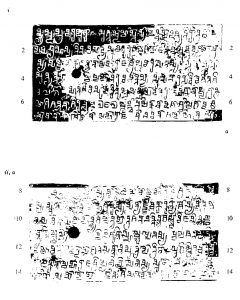
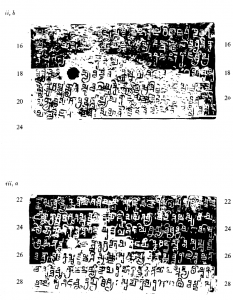
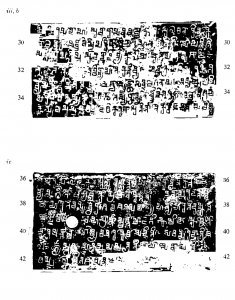

The set of four copper plates was discovered by Shri Ramchandra Narayan Wakadiker whilst digging in the ramparts of Paunī. The charter was issued from Pravarapura and records the donation of land measuring 50 nivarttanas by royal measure to Duggāryya, a student of the Ṛigveda and part of the Aupamanyava gotra. According to the inscription the land is located in the ‘holy place of Achalapuka’ and was given in exchange for another plot of land. The grant was issued in the 32nd year of Pravarasena II’s reign and provides the last date for the rule of Pravarasena II, showing that he ruled at least 32 years.
IN00187 Yavatmal Final Charter Fragment of Pravarasena II, Year 26
IN00186 Yavatmal Charter Fragment, probably of Pravarasena II
IN00185 Miregaon Charter of Prabhavatigupta

The set of five copper plates were found when a field was being dug near the village of Mirēgaon. The inscription records the donation of the village Jalapura-vāṭaka to support a group of Brāhmaṇas by Prabhāvatī Guptā in the 20th year of the reign of her son, Pravarasena II. The contents of the plates are the same as the Ṛiddhapur plates except for the details of donations. The plate was drafted by a minister named Candra.
IN00184 Masod Charter of Pravarasena II, Year 19

This charter, issued in the 19th year of Pravarasena II’s reign, records the donation of a piece of land in the north west of Matsakadraha village in honour of 19 Brāhmaṇas who are named in the inscription.
IN00183 Mandhal Charter of Pravarasena II, Year 17
This set of five copper plates were discovered during archaeological excavations undertaken at Māṇḍhaḷ by the Department of Ancient Indian History, Culture and Archaeology, Nagpur University. These plates were discovered with two other later Vākāṭaka copper plate charters. Each charter was complete with ring and seal attached. This charter was issued from Pravarapura and it records the donation of the village Mayasagrāma in favour of Upādhyāya Māṭrisvāmin by Pravarasena II. The charter dates to the 16th and 17th year of Pravarasena II reign, with the first date recording the year when the donation was made and the second year recording when the charter was written and issued. According to the inscription one third of the religious merit of the donation is to go to Ājnākabhaṭṭārikā, mother of Narendrarāja, although it is not known who these two people are. According to Shastri, the identification of Mayasagrāma is not possible at present, but it is also not possible to rule out Māṇḍhaḷ as the possible location of the ancient village.
IN00182 Mandhal Charter of Rudrasena II, Year 5
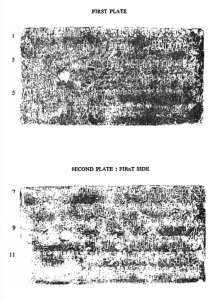
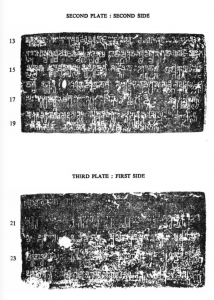
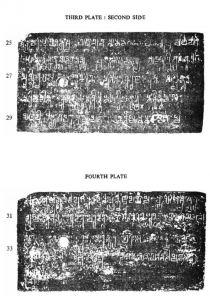
This set of four copper plates was discovered during the ploughing of a field in the village of Māṇḍhaḷ in 1982. The plates date to the 5th year of Rudrasena II’s reign and record the donation of four villages, Selludraha, Achchhabhallikā, Suragrāmakā and Aragrāmakā, which were used as a Brāhmaṇa settlement, occupied by Brāhmaṇa’s from different sects. The charter was written by Senāpati Vibhīshaṇa for Rudrasena II, and is stated to have been issued by the king himself following a command from Viṣṇu. Records so far do not specify in which field the copper plates were discovered.
IN00181 Ajanta Cave 4 Image Inscription
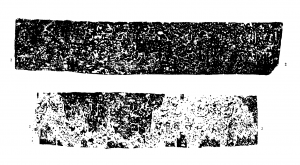
IN00180 Ajanta Cave 17 Inscription of Ravisamba
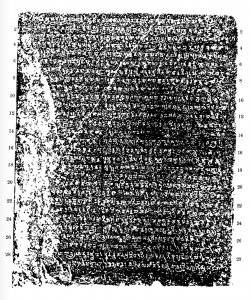
This stone inscription, inscribed on the side wall of the outside veranda of cave 17, is much damaged by exposure, which according to Shastri (1997: 46), has lead the correct decipherment of the inscription to be very problematic. The inscription starts with a dedication to the Buddha, unusual as many of the Vākāṭaka period inscriptions and charters are dedicated to Hindu gods. The inscription was carved to record the creation of Buddhist stupas and institutions by a ruler called Dharādhipa and with the wish for the longevity of these structures. The inscription was carved under the name of Ravisāmba, a vassal of the Vākāṭaka king Hariṣeṇa. The inscription also includes a genealogy for Dharādhipa and Ravisāmba.